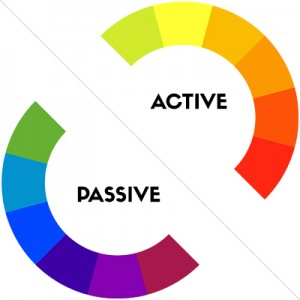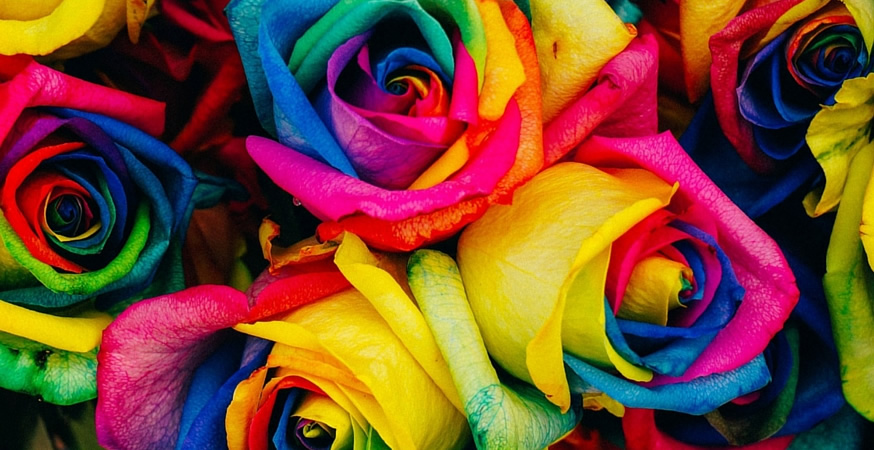In Part 1 of our Color Theory blog series, we learned that color theory is a logical system for organizing color and took a closer look at the basic building block of color theory – the color wheel. Seems pretty simple, right? Today, we’re going to dig a little deeper into the color wheel and take a look at active versus passive colors.
Here we go.
What are Active and Passive Colors?
The distinction between active and passive colors isn’t complicated; basically, active colors are warm colors and passive colors are cool colors.
Active Colors: In general, active colors are brighter. They’re considered “active” because they are more likely to excite the mind and be perceived as sources of energy. Active colors are commonly associated with traits like strength, confidence, enthusiasm, and exuberance.
Passive Colors: Passive colors are more neutral and toned-down than active colors. They tend to promote mental focus, and often have a calming effect. Passive colors are associated with calmness, introspection, quiet, and comfort.
So far, so good. Let’s move on.

How to Use Active and Passive Colors
Each color and shade on the color wheel creates an unconscious association with particular feelings, traits, or characteristics (this is called “color psychology”. We’ll talk about it in detail in a later post.) When you’re choosing a color palette, it’s important that you keep these unconscious associations in mind.
Often, your color palette will be determined by the content of your photos, design elements, or by your client’s branding or personal preference. But if you’re building a color palette from scratch, it helps to keep these associations in mind:
Red
 Active or Passive: Active
Active or Passive: Active
Common Uses: Red is often used by restaurants to stimulate appetite. It also creates a sense of urgency, which is perfect for encouraging action or promoting a sale.
Emotional Associations: Power, passion, excitement, courage.
Orange
 Active or Passive: Active
Active or Passive: Active
Common Uses: Orange is an aggressive color, so it’s ideal for making design elements like calls to action stand out. Be careful when using orange – if you use it poorly, it can make your design feel frivolous or juvenile.
Emotional Associations: Playfulness, energetic, happiness, confidence.
Yellow
 Active or Passive: Active
Active or Passive: Active
Common Uses: Nothing compares to yellow’s ability to grab attention. However, use too much yellow and you run the risk of causing visual fatigue.
Emotional Associations: Optimism, youthfulness, friendliness.
Green
 Active or Passive: Passive
Active or Passive: Passive
Common Uses: Green is a very soothing color. Use green to evoke a sense of calmness and tranquility, or to symbolize nature or prosperity.
Emotional Associations: Wealth, relaxation, nature.
Blue
 Active or Passive: Passive
Active or Passive: Passive
Common Uses: Blue is widely loved, and is therefore a non-threatening, conservative color choice. It’s also a productive and non-invasive passive color, which makes it ideal for corporate communications. Experiment with different shades of blue – the wrong tone can make your design appear cold.
Emotional Associations: Security, trust, communication
Purple
 Active or Passive: Passive
Active or Passive: Passive
Common Uses: Because of its association with royalty, purple is commonly used to create a sense of luxury. However, purple can also appear very whimsical, so be sure to use the right shade.
Emotional Associations: Creativity, wisdom, luxury
Tips for Using Active and Passive Colors
Balancing active and passive colors is a key component of creating an effective, pleasing color palette. Here are our tips for working with active and passive colors:
- Combine active and passive colors in the same design. Using only active colors can overwhelm your reader’s eye, while using only passive colors can seem a bit lackluster.
- Use active colors sparingly to bring your reader’s attention to a specific focal point.
- Experiment with different shades. Certain shades of a color connote different meanings – for example, a bright mauve purple can indicate whimsy, while a deep purple might indicate wealth and prosperity.
- If you’re working with photography, choose colors that coordinate with the shades in your photos. This will create a sense of unity and cohesiveness within your design.
Get Active (or Passive)!
Active are bright and energetic compared to soothing, neutral passive colors. Both are essential to creating an effective, pleasing design, so play around with different combinations till you achieve the perfect balance.
Stay tuned for Part 3 of our Color Theory series! We’ll be taking a closer look at the difference between warm and cool colors.
Read More
Part 1: Introduction to Color Theory and the Color Wheel
Part 2: Active versus Passive Colors (you’re here!)
Part 3: Warm and Cool Colors
Part 4: Additive and Subtractive Colors
Part 5: Color Harmonies



